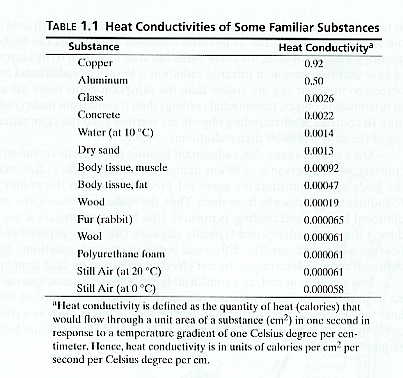The atmosphere and the Weather
![[Home]](../../icons/home.jpg)
![[Lectures]](../../icons/lectures.jpg)
![[Previous]](../../icons/previous.jpg)
![[Next]](../../icons/next.jpg)
The next topic concerns how the human body exchanges energy (or heat)
with its surroundings. This will include how the body responds to both
hot and cold temperatures AND how humidity and winds factor into the
heat exchange. This will lead us to the concepts of wind chill factor
and heat index.
Energy Transfer
We start with a few basics. Keep in mind the material presented here
is somewhat simplistic. In reality energy expenditures and transfers
can do more than just change the temperature of an object.
- For an object to warm, energy must be added
- For an object to cool, energy must be removed
- Energy balance for an object (that does not produce energy internally):
- If energy in = energy out, temperature of object remains constant
- If energy in > energy out, temperature of object increases
- If energy in < energy out, temperature of object decreases
- Energy is transferred between objects that are at different temperatures. The direction
of energy transfer is ALWAYS from hot --> cold.
- There are three mechanisms of energy transfer:
- Conduction (discussed below)
- Convection (discussed below)
- Radiation (discussed later in the semester)
Conduction is the transfer of energy by direct collisions of molecules (touching).
Energy can be conducted from one object to another or within a single object that
contains temperature variations. The rate at which energy is transferred within a
material is referred to as its heat conductivity. For example, take a rod of steel.
Heat the rod at one end and measure how quickly heat is conducted toward the other end.
In general, solids and liquids are better heat conductors than gases because the molecules
that make up solids and liquids are more tightly packed than in gases. Thus, water and
metals are good heat conductors, while air is a poor heat conductor (or a good heat insulator).
 When two different
objects touch heat is always transferred from the warmer object to the colder object. If you
touch something hot, energy is transferred from the hot object to you. If you touch something
cold, energy is transferred from you to the cold object.
When two different
objects touch heat is always transferred from the warmer object to the colder object. If you
touch something hot, energy is transferred from the hot object to you. If you touch something
cold, energy is transferred from you to the cold object.
The rate of conductive heat transfer depends on:
- Temperature difference between the objects (Larger temperature difference, the faster the heat transfer)
- Conductivity of the material (e.g., conductive heat transfer in water much faster than in air)
The latter reason will be used in class to explain why double-paned glass windows are more energy efficient than
single-paned glass windows. And why swimming in water at a temperature of 70 degrees Fahrenheit feels cold,
while standing outside when the air temperature is 70 degrees Fahrenheit does not. We will also discuss another reason why
heat conduction away from the human body is so slow in still air.
Convection is the transfer of heat by actual movement of mass within a fluid. Convection is a
very important means of energy transport in the atmosphere, especially moist convection.
Convection only
occurs in fluids (liquids and gases), not in solids.
Two types of convection are important in the atmosphere:
- Dry convection
- Natural - (warm air rising, cold air sinking)
- Forced - (winds stir up the air, mixing it around)
- Moist convection
- Accounts for energy removed due to evaporation of water (usually from
near the ground surface), then delivered when the water condenses (usually high in the atmosphere
where clouds form).I find students often have difficulty understanding this process. Recall
that water vapor contains more internal energy than liquid water. When water evaporates, you
can say that the energy, which was used to evaporate the liquid, is stored in the water vapor. This
stored energy is released when the water vapor condenses back to liquid water. Overall, energy
is removed from the region where the water evaporated and released where the water condenses, thus
transferring energy from one location to another.
- The rate of heat loss via evaporation depends on the net rate of evaporation, which
as we have seen depends on the relative humidity. In class, we will also discuss why
evaporative heat loss by the human body is also affected by winds.
All three mechanisms of energy transfer, conduction, convection, and radiation, play a role in how
the human body exchanges energy (heat) with the external world. We have only covered the
processes of conduction and convection. The next page describes how the human body deals with
heat and cold stress and how weather conditions impact heat loss from the body.
![[Home]](../../icons/home.jpg)
![[Lectures]](../../icons/lectures.jpg)
![[Previous]](../../icons/previous.jpg)
![[Next]](../../icons/next.jpg)
